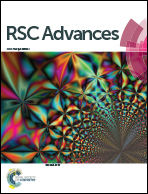Degradation of disperse blue 2BLN by oleaginous C. sorokiniana XJK
Abstract
In this study, an oil-producing freshwater microalgae Chlorella sorokiniana XJK was identified and used for the degradation of disperse blue 2BLN. According to the decolorization rate, the optimal conditions were found to be as follows: initial dye conc. = 60 mg L−1, initial biomass density = 8 × 106 cell per mL, initial pH = 4, light intensity 470 μmol (m2 s)−1 and CO2/air (v/v) ratio = 1%. The decolorization rate reached up to 83% in 6 days cultivation with Chlorella sorokiniana XJK, which also obtained 570 mg L−1 of biomass and 43% of lipid content under the optimum conditions. Moreover, the enzyme activities (laccase and manganese peroxidase) in XJK were determined to be 3.89 U mL−1 and 4.86 U mL−1, respectively, which played a significant role in dye decolorization. The degradation products of the dye were analyzed by UV-vis, FTIR and GC-MS methods. This revealed that the major chromophore group was broken down and disperse blue 2BLN was converted into several low-molecular compounds including dibutyl phthalate, ethylbenzene and ethyl acetate during the microalgae-based treatment. This indicated that XJK shows a potential for dye degradation and providing materials for biofuel.


 Please wait while we load your content...
Please wait while we load your content...